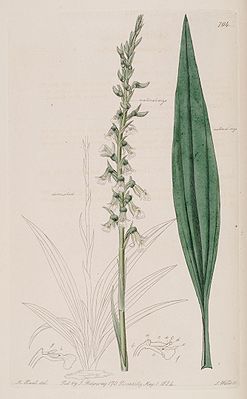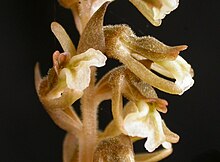Cyclopogon
| Cyclopogon | ||||||||||||
|---|---|---|---|---|---|---|---|---|---|---|---|---|

Cyclopogon bicolor , illustration from "The Botanical Register" |
||||||||||||
| Systematics | ||||||||||||
|
||||||||||||
| Scientific name | ||||||||||||
| Cyclopogon | ||||||||||||
| C. Presl |
Cyclopogon is a genus from the family of the orchid (Orchidaceae). It contains more than ninety types of herbaceous plants that are native to tropical America.
description
The species of the genus Cyclopogon form strongly compressed shoots on a rhizome , which above ground produce a rosette of leaves and below ground a tuft of fleshy, hairy, spindle-shaped or cylindrical roots . The stalked leaves are oval to lanceolate in shape, pointed at the end. In some species the leaves are brownish, light green, white or dark green stripe patterns appear quite often on the leaves.
The terminal, racemose inflorescence is covered with bracts at intervals and hairy at least in the upper part. The resupinated flowers are one-sided in some species. They are somewhat drooping, fleshy, tubular, often fragrant. There are greenish, whitish or brownish colors, the lip is white, often with darker markings. The ovary is cylindrical to slightly spindle-shaped, sessile or very short-stalked, hairy, somewhat twisted and curved. The sepals are free or fused tubular at the base. All three sepals are somewhat bowl-shaped at their base, with only the two at the side enclosing a nectarium. The petals lie against the dorsal sepal. The lip is abruptly narrowed (“nailed”) at the base, followed by two laterally directed nectar glands. The middle part of the lip is shaped like a groove, the sides are turned up and cling to the column . The front part of the lip is widened again after a constriction, often somewhat three-lobed, covered with calluses or hair. The column is club-shaped with a short "column foot". The sessile stamen is oval with a membranous extension at the tip, it contains two pollinia . These are furrowed lengthways, of a floury consistency, they hang over with a small stalk each on a shared adhesive disc (Viscidium). The scar distinguishable or merging areas. The dividing tissue between the stamen and stigma (rostellum) is elongated, fleshy, it ends bluntly.
In some species, bees from the Halictidae family ( Augochloropsis , Dialictus , Pseudoaugochloropsis ) have been observed as pollinators. The pollinia cling to the head. Due to the floury, crumbly consistency, several flowers can be pollinated with one pollinium.
The known chromosome numbers vary over a wide range from 2n = 28, 30, 32, 45, 56 and 66.
Occurrence
Cyclopogon is common in tropical America. From Florida and Mexico in the north, the genus occurs across Central America and the Caribbean to Argentina and Uruguay in the south. Altitudes up to 3000 meters are settled. Cyclopogon obliquus occurs adventively in Southeast Asia.
The locations are diverse: in addition to moist forests, there are also species that occur in savannas, grasslands, swamps or moors. Most species grow terrestrially, but there are some epiphytes .
Systematics and botanical history
Cyclopogon is classified within the tribe Cranichideae in the subtribe Spiranthinae . The genus was classified by Burns-Balogh in the so-called Pelexia group, which Szlachetko regarded as a separate subtribe Cyclopogoninae. Recent studies have identified Pelexia and Sarcoglottis as related genera .
Cyclopogon was first described by Presl in 1827 . The name Cyclopogon is made up of the Greek words κύκλος cyclos , "circle" and πώγων pogon , "beard". The reference is unclear, Garay explains, pogon means something like "fire tail with split ends", which describes the reddish inner petals of dried herbarium specimens that protrude from the circle of the outer ones. Type species is Cyclopogon ovalifolius .
Garay saw the difference between the type species and the other species of the genus as so serious that he established a new genus Beadlea for the latter . Later authors argued that with this difference - the degree of intergrowth of the petals - there were smooth transitions and no sharp dividing line between genera. Other genera that have been proposed as separate are Cocleorchis and Warscaea (mostly used as synonyms) and Stigmatosema .
The species of the genus Cyclopogon :

- Cyclopogon adhaesus Szlach. : Ecuador
- Cyclopogon alexandrae (Kraenzl.) Schltr. : Southern Brazil
- Cyclopogon antioquiensis Szlach. & Kolan. : Colombia
- Cyclopogon aphyllus Schltr. : It is also placed as Pelexia goyazensis (Cogn.) Garay in the genus Pelexia .
- Cyclopogon apricus (Lindl.) Schltr. : Bolivia to northern Argentina
- Cyclopogon argyrifolius (Barb.Rodr.) Barb.Rodr. : Southeastern and southern Brazil
- Cyclopogon argyrotaenius Schltr. : Colombia to Ecuador
- Cyclopogon bangii (Rolfe ex Rusby) Schltr. : Bolivia
- Cyclopogon bicolor (Ker Gawl.) Schltr. : Northeast Colombia to northwest Venezuela, Trinidad, Brazil to northeast Argentina
- Cyclopogon calophyllus (Barb.Rodr.) Barb.Rodr. : Southeastern Brazil to northern Argentina
- Cyclopogon camara-lereti Szlach. & Kolan. : The species first described in 2019 occurs in Colombia.
- Cyclopogon carinianus Pansarin : Brazil
- Cyclopogon casanaensis Schltr. : Bolivia
- Cyclopogon cearensis Barb. Rodr. : Northeastern Brazil
- Cyclopogon chloroleucus Barb. Rodr. : Southeastern and southern Brazil to Argentina
- Cyclopogon cochabambae (Szlach.) JMHShaw : Central Bolivia
- Cyclopogon comosus (Rchb.f.) Burns-Bal. & EWGreenw. : Mexico to Panama
- Cyclopogon condoranus Dodson : Ecuador
- Cyclopogon congestus (Vell.) Hoehne (Syn .: Cyclopogon bidentatus (Barb.Rodr.) Szlach. ): Southeastern and southern Brazil to northern Argentina
- Cyclopogon cotylolabium (Szlach.) Carnevali & GARomero : Venezuela
- Cyclopogon cranichoides (Griseb.) Schltr. : Southern Florida to Tropical America
- Cyclopogon deminkiorum Burns-Bal. & MSFoster : Southeast Paraguay
- Cyclopogon draculoides (Szlach.) JMHShaw : Brazil
- Cyclopogon dressleri Szlach. : Panama
- Cyclopogon dusenii Schltr. : Southern Brazil
- Cyclopogon dutrae Schltr. : Southern Brazil
- Cyclopogon elatus (Sw.) Schltr. : Southern Florida to Tropical America
- Cyclopogon eldorado (Linden & Rchb.f.) Schltr. : Brazil
- Cyclopogon elegans Hoehne : Eastern Bolivia to Brazil and northern Argentina
- Cyclopogon ellipticus (Garay) Dodson : Ecuador
- Cyclopogon epiphyticus (Dodson) Dodson : Colombia and Ecuador
- Cyclopogon estradae Dodson : Ecuador
- Cyclopogon eugenii (Rchb.f. & Warm.) Schltr. : Southeastern Brazil
- Cyclopogon furculus (Szlach.) JMHShaw : Peru
- Cyclopogon fuscofloralis (Szlach.) Carnevali & GARomero : Venezuela
- Cyclopogon garayanus (Szlach.) JMHShaw : Brazil
- Cyclopogon gardneri Mytnik, Szlach. & Rutk. : Brazil
- Cyclopogon glabrescens (T.Hashim.) Dodson, Brako & Zarucchi : It is also placed as Quechua glabrescens (T.Hashim.) Salazar & L.Jost in the genus Quechua .
- Cyclopogon goodyeroides (Schltr.) Schltr. : Bolivia
- Cyclopogon gracilis Schltr. : Ecuador
- Cyclopogon graciliscapus Schltr. : Southeastern and southern Brazil
- Cyclopogon hatschbachii Schltr. : Southern Brazil
- Cyclopogon hennisianus (Sandt) Szlach. : Colombia and Ecuador
- Cyclopogon hirtzii Dodson : Ecuador
- Cyclopogon iguapensis Schltr. : Southeastern and southern Brazil
- Cyclopogon inaequilaterus (Poepp. & Endl.) Schltr. : Ecuador, Peru and northern Brazil
- Cyclopogon itatiaiensis (Kraenzl.) Hoehne : Southeastern Brazil
- Cyclopogon laxiflorus Ekman & Mansf. : Panama to Ecuador and the Caribbean
- Cyclopogon lindleyanus (Link, Klotzsch & Otto) Schltr. : Venezuela to western South America and Argentina
- Cyclopogon longibracteatus (Barb. Rodr.) Schltr. : Southeastern and southern Brazil to northeastern Argentina
- Cyclopogon luerorum Dodson : Ecuador
- Cyclopogon lunulatus (Szlach.) JMHShaw : Peru
- Cyclopogon luteoalbus (A.Rich. & Galeotti) Schltr. : Mexico
- Cyclopogon macer Schltr. : Ecuador
- Cyclopogon macrobracteatus J.MHShaw : Venezuela
- Cyclopogon maderoi Schltr. : Colombia to Peru
- Cyclopogon maldonadoanus Dodson : Ecuador
- Cyclopogon millei (Schltr.) Schltr. : Western South America to northwestern Venezuela
- Cyclopogon miradorensis Schltr. : Mexico, Honduras, Nicaragua, Panama and the Caribbean
- Cyclopogon monophyllus (Lindl.) Schltr. : It is also called Cranichis diphylla Sw. placed in the genus Cranichis .
- Cyclopogon multiflorus Schltr. : Southeastern and southern Brazil
- Cyclopogon neglectus Szlach., S.Nowak & Baranow : French Guiana
- Cyclopogon obliquus (JJSm.) Szlach. : It is also placed as Pelexia obliqua (JJSm.) Garay in the genus Pelexia .
- Cyclopogon odileanus (Szlach.) JMHShaw : Southern Brazil to Argentina
- Cyclopogon oliganthus (Hoehne) Hoehne & Schltr. : Southeastern Brazil to northern Argentina
- Cyclopogon olivaceus (Rolfe) Schltr. : Northern and Western South America
- Cyclopogon organensis (Pabst) Szlach. & Rutk. : Brazil
- Cyclopogon ovalifolius C. Presl : Costa Rica to Peru
- Cyclopogon paludosus (Cogn.) Schltr. : Southeastern Brazil
- Cyclopogon papilio Szlach. : Guatemala
- Cyclopogon pedicellatus (Szlach.) JMHShaw : Brazil
- Cyclopogon pelagalloanus Dodson : Colombia and Ecuador
- Cyclopogon peruvianus (C.Presl) Schltr. : Western South America to northwestern Venezuela
- Cyclopogon plantagineus Schltr. : Panama to northwestern Venezuela and Bolivia
- Cyclopogon prasophylloides (Garay) Szlach. : Guatemala, Costa Rica, Panama, Colombia
- Cyclopogon prasophyllus (Rchb.f.) Schltr. : Southern Mexico to northwestern Colombia
- Cyclopogon pringlei (S.Watson) Soto Arenas : Mexico
- Cyclopogon proboscideus Szlach. : Brazil
- Cyclopogon pululahuanus Dodson : Ecuador
- Cyclopogon rimbachii Schltr. : Colombia to Peru
- Cyclopogon rotundifolius (Cogn.) Schltr. : It is also called Discyphus scopulariae (Rchb.f.) Schltr. var. scopulariae is part of the genus Discyphus .
- Cyclopogon saccatus (A.Rich. & Galeotti) Schltr. : Mexico
- Cyclopogon sillarensis Dodson & R.Vásquez : Bolivia
- Cyclopogon soniae-juaniorum Zambrano : The species first described in 2018 occurs in Ecuador.
- Cyclopogon spiranthoides Schltr. : Western Colombia
- Cyclopogon stenoglossus Pabst : Southeastern Brazil
- Cyclopogon subalpestris Schltr. : Southern Brazil to Argentina
- Cyclopogon tandapianus Dodson : Ecuador
- Cyclopogon taquaremboensis ( Barb . Rodr .) Schltr. : Southern Brazil to Uruguay
- Cyclopogon torusus Mytnik, Szlach. & Rutk. : Brazil
- Cyclopogon trifasciatus Schltr. : Southern Brazil
- Cyclopogon truncatus (Lindl.) Schltr. : Brazil
- Cyclopogon variegatus Barb. Rodr. : Brazil to Paraguay
- Cyclopogon venustus (Barb. Rodr.) Schltr. : Brazil
- Cyclopogon vittatus Dutra ex Pabst : Southern Brazil
- Cyclopogon warmingii (Rchb.f.) Schltr. : Southeastern and southern Brazil
- Cyclopogon werffii Dodson : Galapagos Islands
- Cyclopogon williamsii Dodson & R.Vásquez : Bolivia
See also
literature
- James D. Ackerman: Cyclopogon . Edited by Flora of North America Editorial Committee. In: Flora of North America . tape 26 . New York / Oxford 1993, p. 520 f . ( efloras.org [accessed February 6, 2008]).
- Leslie A. Garay: 225 (1). Orchidaceae (Cypripedioideae, Orchidoideae and Neottioideae) . Edited by Gunnar Harling, Benkt Sparre. In: Flora of Ecuador . tape 9 , 1978, ISSN 0347-8742 , p. 258 .
- Leslie A. Garay: A generic revision of the Spiranthinae . In: Botanical Museum Leaflets / Harvard University . tape 28 , no. 4 , 1982, ISSN 0006-8098 , pp. 298-299, 308-309 .
- Alec M. Pridgeon, Phillip Cribb, Mark W. Chase, Finn Rasmussen (Eds.): Genera Orchidacearum. Orchidoideae . Part 2. Vanilloideae. tape 3/2 . Oxford University Press, New York / Oxford 2003, ISBN 0-19-850711-9 , pp. 188-192 .
Individual evidence
- ↑ Gerardo A. Salazar, Mark W. Chase, Miguel A. Soto Arenas, Martin Ingrouille: Phylogenetics of Cranichideae with emphasis on Spiranthinae (Orchidaceae, Orchidoideae), evidence from plastid and nuclear DNA sequences . In: American Journal of Botany . tape 90 , 2003, ISSN 0002-9122 , p. 777-795 .
- ↑ a b c d e f g h i j k l m Rafaël Govaerts (Ed.): Cyclopogon. In: World Checklist of Selected Plant Families (WCSP) - The Board of Trustees of the Royal Botanic Gardens, Kew . Retrieved March 29, 2020.

